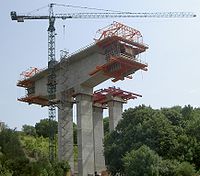Civil engineering
When engineering a discipline of is building industry designates that deals with the planning, construction deals and construction of technical buildings.
As a civil engineering or civil engineering structures are structures called that of civil engineers are individually designed. The technical design effort usually outweighs the design requirements. Engineering structures fulfill functional rather than representative functions.
According to DIN 1076, traffic structures (bridges, tunnels, trough structures, support structures) from a visible height of 1.5 meters are classified as engineering structures, as well as other technical structures for which a static proof is required, such as B. Rainwater retention basins and manhole structures.
Residential and office buildings, commercial and administrative buildings, assembly and cultural facilities, as well as all buildings that predominantly contain lounges , are generally not referred to as engineering structures, although demanding construction tasks and large-scale buildings often require at least as extensive static and constructive calculations .
Modern civil engineering
Civil engineering is divided into two areas:
- Structural engineering (focus on construction)
- Functional engineering (focus on technology)
Structural engineering
Structural engineering usually deals with building structures and systems in the field of technical infrastructure ( supply technology and traffic engineering ).
The focus is on the structural design , in the case of high-rise buildings also in connection with the architectural design. Examples are wide-span machine halls , roof structures , bridges and towers ( television towers ), tunnel projects with difficult geology , unusual caverns and dams or heavily loaded wind turbines .
Many engineering structures lie below the earth's surface and are not visible. In the soft subsoil of sedimentary basins and in loose rock, as well as in the groundwater or below the sea surface, complex precautions must often be taken for the construction of underground structures or foundations .
Functional civil engineering
Functional engineering refers to the development of the physical-technical basics and sets of rules, on the basis of which the calculation and execution of structures (structural engineering) takes place: building physics , material science , aging and wear , loading and dimensioning methods, methods and procedures (structural connection technology , concrete casting ua) as well as overarching aspects of energy-efficient and sustainable building .
Historic buildings that are considered milestones in engineering
- the Eiffel Tower
- the Hagia Sophia as the world's first large dome
- some of the seven wonders of the world ,
- the colosseum
- of St. Peter's Basilica and its static restoration (see Roger Joseph Boscovich )
- the pyramids of Giza
- the Hezekiah water tunnel in Jerusalem
- the unusual telescopes of the observatories of Paris or Vienna or the mounting of the Grand mirror at Mount Palomar
- the first mountain railway over the Semmering , the first Gotthard tunnel or the viaducts in the Odenwald
- the Roman aqueducts or the high spring pipeline to the Hochschwab
- the ancient cut of the Suez Canal
- the bridges over the Trisanna Gorge or the Firth of Forth
- the roof structure of the Munich Olympic Stadium

